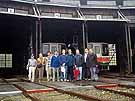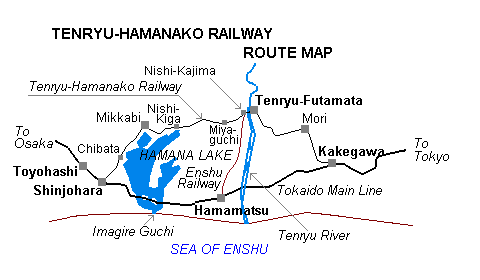
JRS members who participated in the excursion in front of the historic roundhouse.

JRS members who participated in the excursion in front of the historic roundhouse.
|
By Hiroshi Naito
 On October 28th Saturday, gathered at Shinjohara on the
Tokaido Main Line were nine Japan-based JRS members, who were from the
Tokyo and Nagoya areas, to participate in one of the Society's regular
activities.
On October 28th Saturday, gathered at Shinjohara on the
Tokaido Main Line were nine Japan-based JRS members, who were from the
Tokyo and Nagoya areas, to participate in one of the Society's regular
activities.
Our destination was Tenryu-Futamata engine depot on the Tenryu
Hamanako Railway (Tenhama Line), a third sector operator, where we
visited a historic wooden roundhouse still in service. We traveled to
Tenryu-Futamata along the Tenhama Line, which takes an altanative route
to the Tokaido Line between Kakegawa and Shinjohara. Another of our aim was to ride a semi-open coach train, dubbed 'Torokko Soyokaze', from Mikkabi
on the way to Tenryu-Futamata. We were greeted by Yuichi Nagabuchi, an
employee of the railway. He was kindly escorting us to Tenryu Futamata.
Unfortunately, the weather was not favorable, with a thickly overcast
sky.
At a short platform adjoining the tracks of the Tokaido Main
Line, we boarded a single unit diesel railcar, type TH1, typical
rolling stock of the railway's fleet. The car was in its four-colour
livery, green, orange, blue and white, from which one could be given a
somewhat strong impression in colouring. The car was smaller in size
light in weight in contrast to equipment for ordinary heavy railways.
This kind of light railcar is so designed as to meet the requirements
of less-busy light lines, pursuing low cost in production and
cost-effectiveness in maintenance. It utilizes bus technology in every
possible aspect. The railway introduced this type of rolling stock when
it originated in 1987, taking over the ex-national railway's (JNR's)
Futamata Line, which was discontinued as a result of the JNR
privatization. The introduction of this type of rolling stock was one
of the key strategies for the railway in reducing operation cost, and
thus enabled the start of a new rail service reviving the pitiful rural
line abandoned by the old JNR.
Our single unit train started fairly well loaded with
passengers. We took seats in a section just behind the front vestibule.
Behind the cab was the passenger interface equipment for one-man
operation, a ticket machine with an electric fare indication board on
it. Our guide, Yuichi Nagabuchi made announcements at station stops,
acting as a temporary guard. The train proceeded along the single track
route with repetitive rail joint sounds typical of a single unit train.
However, riding was smooth enough, probably because of the well
maintained track bed. Outside of the windows it immediately turned to
off-the-main-line scenery, with rice paddies, low hills and small woods
alongside. At Chibata, the first loop, we met a railcar going down in the opposite direction. Enjoying a twenty-minute railbus ride, we arrived at Mikkabi,
where the semi-open coach train, 'Torokko Soyokaze' meaning 'a trolley
in a gentle breeze', was awaiting us. The weather grew worse, and
finally it started raining.
The formation of the Torokko Soyokaze was two semi-open coaches,
which were converted from open wagons, behind a type TH1 diesel
railcar. The other end of the semi-open coach was a control cab, which
allows push-pull operation in multiple-unit control mode. The train is
in a nice brown and cream livery. Inside the coach was wooden interior,
with wooden chairs and tables, which gave a really warm ambiance.
On-board attendants were a guard and a female guide along with Yuichi
Nagabuchi. The train started and we finally set out for a one hour and
twenty minutes journey, feeling gentle breezes. Soon, a beautiful
waterside sight of the Hamana Lake came into view, although visibility
was not very good because of the dark weather. The train proceeds along
the lake shore, and we sometimes found ourselves close to the lake
itself. The water front we were seeing was actually Inohana Lake (wild boar's nose lake), an inlet of the main lake.
Among lakes in Japan, Hamana Lake is very special with its salty water. It is connected to the Ocean through a mouth, called Imagire Guchi, which breaks the long stretch of sands of the Sea of Enshu.
Sea water comes in and out of the lake through this mouth according to
the ebb and flow of the tide. The lake was once separated from the
Ocean with a narrow sand belt forming a fresh-water lake. But, one day
some hundred years ago, a typhoon hit and broke the sand belt,
resulting in Hamana Lake being a unique sea water lake. When you travel
across the western part of Shizuoka prefecture, whether by the Tokaido
Shinkansen or the conventional Tokaido Main Line, you cross Hamana Lake
by three bridges. At that time, the north side of your train is the
main water area of scenic Hamana Lake. From the south side windows, you
will see a high bridge of the national road #1 in the distance over the
lake. Below the bridge is the mouth of Hamana Lake, Imagire Guchi, meaning now-broken mouth, where a rapid stream of sea water goes by.
Leaving Inohana Lake, the viaduct of Tomei Expressway
came close to our route from the north. Then, it crossed over us and
went away to the south. The northern landscape changed a more
mountainous one with dense trees on a gradually rising slope. Again,
Hamana Lake came into view, and the train rolled along the lakeside
allowing us to see the lake beyond the road parallel to the track. The
female attendant continued providing us with narrative guidance of the
landscape along the line. On the lake water, frequently seen were
flights of ducks here and there, which seemed to have newly migrated
from Siberia this year. Thanks to her, we came to know that Hamana Lake
is known as one of the most famous duck-breeding places. Now, we were
around the deepest end of Hamana Lake, which is most scenic with small
inlets and peninsulas forming an intricate landscape of the lake coast.
The members were enjoying the semi-open coach ride, despite gloomy
weather with worsened rain. Without window glazing, scenery was close
at hand, providing us with favorable photographing opportunities.
As we left Nishi-Kiga, where we met a west-bound train
again, the lake finally was gone to the south. The train proceeded for
a while across rural scenery on flat land with rice fields at both
sides. Then, the train began taking a fairly steep gradient in
mountainous surroundings. Going through tunnels and cuttings, seen at
both sides were densely grassed low cliffs with forests above them.
Yuichi Nagabuchi informed us that we were now going up along the line's
steepest section, 2.5 percent, and approaching to the summit. During
the JNR Futamata Line days, there was freight work with steam haulage.
Tenryu-Futamata (formally Totoumi-Futamata) based C58s used to gasp on
this section climbing up the gradient with the assistance of a C58
behind. Even our diesel-powered train slowed down because of the
continuous gradient. Emerging from the tunnel at the summit, our train
resumed speed and rolled down to the open land at the edge of Mikatabara Plateau stretching north of Hamamatasu city. The train arrived in Miyaguchi,
where a stop of an about ten minutes was provided because of a wait for
another westward train. Around the station is a sparsely populated area
with vegetable fields, farms and small thick woods. It is good for
passengers to be able to get out of the train and walk around the
station area at this rural spot.
The former JNR Futamata Line was opened in 1940, just before the
outbreak of World War II. In the days nearing war, the construction of
the line was boosted intending to secure a detour route of the Tokaido
Main Line in case Hamana Bridges were destroyed by air attacks or
attacks from battle ship guns. The line thrived most in the 50s and the
early 60s, with both passenger and freight traffic. Goods transported
by the line were logs, timber, cement, orange, tea, and so on. With a
peak in 1965, the line's business rapidly declined, and the freight
transportation was discontinued in 1987. My memory of the Futamata Line
dates back to when I was a high-school student. I traveled along the
eastern parts of the line between Kakegawa and Nishi-Kajima.
The train was a semi-streamlined diesel railcar Kiha 07, which operated
by means of mechanical transmission. The second memory of the line was
several years later when I was a university student. I traveled along
the entire route from Toyohashi through Kakegawa (the
Futamata Line trains used to go onto the Tokaido Main Line as far as
Toyohashi). The rolling stock at that time was a two-car Kiha 10
series. I enjoyed seeing token exchanging work at each interlocking
loop and wire-operated semaphores, with which I was not very familiar.
The fourth experience was about 20 years ago with my small daughter on
a Kiha 20 series diesel train between Kakegawa and Totoumi-Futamata.
The train was almost empty and I worried about the fate of the line
because of the proposed government policy of abandoning less-traveled
rural lines. The fifth ride on the line was three years ago when I had
a return trip between Kakegawa and Shinjohara with
Oliver Mayer, the German JRS coordinator. The line was already the
current Tenryu Futamata Railway, so we traveled in a type TH1 diesel
railcar. Now, I could be enjoying the sixth experience of the line, but
the scenery along the line remains almost unchanged and I thought I
would never be fed up with this nostalgic railway ambiance.
Leaving Miyaguchi, the next stop is Nishi-Kajima,
an interchange with the Enshu Railway, which connects to Hamamatsu. We
were coming back to this station after the visit to Tenryu-Futamata
depot to go to Hamamatsu. The train passed by the Enshu Railway's depot
and we caught a glimpse of some electric cars in their red livery
resting in the depot sidings. After a station stop at Nishi-Kajima,
our train took the final run towards Tenryu-Futamata. Meanwhile, we
crossed the great Tenryu River, seeing a magnificent suspended road
bridge just upstream of us. Passing through a tunnel, now we were
entering the town of Futamata, which is situated in a valley area. With
a tall supermarket building, catching a little bit an urban atmosphere,
we finally arrived at Tenryu-Futamata. Tenryu-Futamata is the line's
most strategic point with its head quarters and an engine depot, where
all diesel railcars and on-board crews are based. Having densely
forested mountainous areas just behind, the town of Futamata once
prospered with the logging and timber industry. The station used to be
busy shipping logs and timber loaded on open wagons. Thus, the station
still retains a wide yard area, but we could not see any rails in the
area. Being escorted by Yuichi Nagabuchi, we got into the old JNR's
Totomi-Futamata engine depot in drizzling rain.
In the engine depot were an assortment of old JNR wooden
facilities, a roundhouse with a turntable in front, a crew management
office and a maintenance building, as well as an old water tower, all
of which were remnants from good old days of railways. Missing were
steam and a smell of burnt coal. The rolling stock we now see are light
diesel railcars, but once C58s and Kiha 20 DMUs were dominant in this
depot area.
Finishing the tour of the Tenryu-Futamata engine depot, we got
to Hamamatsu via Nishi-Kajima and the Enshu Railway. Some members went
back to Tokyo, and the others went to Toyohashi for accommodation for
the next day's further enthusiastic activities.
All photos were taken by the author in October 2000, unless specified.
Click here for more detailed information and photos of the roundhouse.